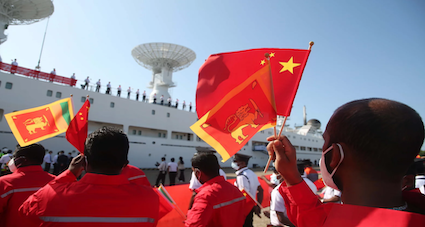The India-China spat on Sri Lanka is astonishingly brawny which doesn’t do justice to two who straddle Asia more than anyone else and who are looked up to by most to end the Western hegemony in company with Russia.
More than anything else, it shows lack of respect and shrill ego when an ambassador addresses the public on India’s interference and the latter bristles at his lack of etiquette, “reflecting a larger national attitude.”
Those who dream of a New World Order could wonder if diplomatic channels of communication between the two neighbours and massive trade partners is so clogged that they needed to strut in public, belying all those bonhomie in BRICS and SCO and the emergence of a new dawn.
The bare facts are that Sri Lanka shrank at India’s insistence in refusing Yuan Wang 5, a Chinese research and survey vessel, to dock at Hambantota port but not for long as the islanders did accommodate the Chinese a few days later.
China, all along, has maintained that the vessel was for “replenishment” while India has been agitated it could track India’s satellite, rocket launches and other installations.
Two things in the Indian response though need clarification for it amounts to slandering which China doesn’t deserve: It states “opaqueness” and “debt-driven agendas” which are “major challenges to smaller nations.”
The truth is, 81% of Sri Lanka’s all debt is owed to West or Japan and India. The share of Beijing is a mere 10 per cent.
Let’s do a more nuanced breakdown: 47% of Sri Lanka’s debt is owed to Western vulture funds and banks. The United States, which dominates Asian Development Bank and the World Bank holds 13% and 9% of Sri Lanka’s external debt.
Japan holds 10% of Sri Lanka’s external debt. India, till April 2021, had held only 2% of Sri Lanka’s debt but it has increased staggeringly this year: Indeed, India was the top lender to Sri Lanka at the start of 2022. It distributed 550% more credit than Beijing between January and April this year. India, in all, has provided $4 billion dollars of assistance to Sri Lanka.
So accusing China of indulging in “debt-trap”, not just in Sri Lanka but anywhere else in the world, is buttressing the Western propaganda. Just to take an example, we have the instance of the Wall Street Journal headlining “China’s loans under fire as Sri Lankan debt crisis deepens” recently.
Nobody is denying China has financed several major infra projects in Sri Lanka: From constructing a top class international airport, hospitals, sport stadium to, yes, the one of Hambantota port.
But the truth is, the Hambantota port assistance was sought by the Sri Lanka from the Chinese and not the other way around. Further, the port is not allowed to use the Chinese navy ships and its emphasised at length in the contractual agreement.
Even the BBC has admitted that it’s not the debt but the equity that the Chinese have in projects in Sri Lanka.
India could have its “security concerns” with the presence of Yuan Wang 5 in Sri Lankan waters as China could be aggrieved at the growing resolve of QUAD nations, to which India and Japan are members, to encircle it in Asia-Pacific.
India, similarly, could feel peeved at the still unresolved issue of LAC (Line of Actual Control) at its borders where its army is squaring off the People’s Liberation Army for months; Or that China blocks its attempts to have certain terrorists from across the border designated as “global threats” in the United Nations.
China, on its part, could be hurt at how Vivo, a smartphone manufacturing company, has been raided in recent times or how its Tibet wound has been kept festering for decades in the presence of Dalai Lama in India.
India of today is extremely aspirational. It’s not a fragile economy of 10 years ago. It’s a big player on global geopolitical stage too. It suits New Delhi if it keeps both West and China interested and thus gain that room to manoeuvre for its national interests, without appearing to be part of any bloc.
China, on its part, can’t be too overtly friendly to New Delhi for its a geopolitical necessity to keep a rising neighbour in check. That it does by keeping Pakistan on India’s heels and petulance such as is being exhibited on Kashmir, Galwan Valley and Hambantota port.
How one wishes that all these Indo-China irks are nothing but to confuse West which doesn’t have the welfare of either in its heart. If all this is meant for the cheers from the side gallery of Washington and London, while BRICS and SCO gain the necessary momentum to integrate Eurasia, ever so quietly, it’s a necessary spectacle. One won’t mind this bitter pill as long as this one opportunity in centuries isn’t wasted.


